Restoring an Icon: The Memphis Belle
On September 30, 1942, when B-17F heavy bomber 41-24485 touched down in Prestwick, Scotland, following a 12-hour flight across the Atlantic Ocean, the American contribution to the air war against Germany was just beginning.
After incurring unacceptable losses in their respective raids against each other’s territory, the German and British air forces had abandoned daytime bombing—and all but the barest pretense of aiming at purely military targets—in favor of attacking each other’s cities. Both sides essentially adopted a revised definition of “strategic” bombing: the strategy now was to undermine the civilian population’s will to fight by targeting metropolitan areas at night, which would presumably induce the enemy’s political leadership to sue for peace.
The commanders of the United States Army Air Forces, however, were determined to implement their doctrine of destroying the enemy’s capacity to fight through precision daylight bombing against specific military and industrial installations. While the necessity of a long-range fighter escort that could accompany the bombers on deep penetration raids would ultimately become evident to the American commanders, in this first phase of the campaign against Germany they were convinced that a “combat box” of well-armed bombers, flying at high altitude in close formation, would provide sufficient protection against the defenders’ interceptor aircraft.
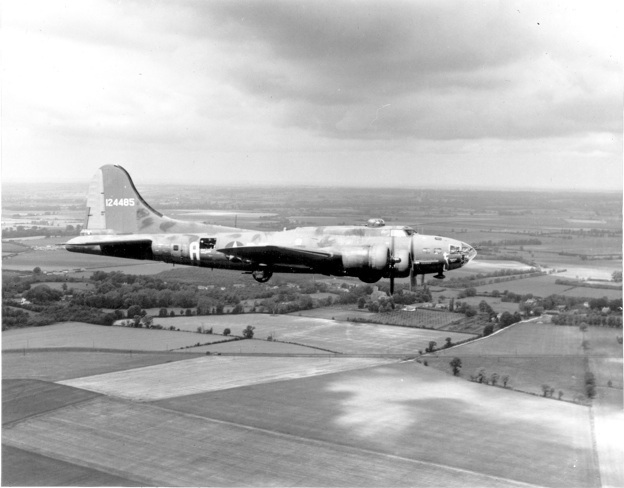
The B-17 was a rugged machine. It acquired a reputation for being able to sustain severe battle damage and still make it back to England. The structure of the airframe could maintain its integrity even when hit by shrapnel from flak—the English-speaking allies borrowed the acronym from the German term flugabwehrkanone (air defense cannon)—or by gunfire from attacking German fighter aircraft, whose pilots quickly adapted to the bomber combat box by attacking head-on from the “12 o'clock high” position, at a terrifying closing rate approaching 600 miles per hour, in order to minimize their exposure to the formation's defensive weapons.
Although the frame of the B-17 could take a lot of punishment, its aluminum skin was easily punctured; a man could poke a screwdriver through it. Its engines could be disabled by enemy gunfire and its large wing tanks of aviation fuel were an ever-present fire hazard. Even if the aircraft held together, and its engines didn’t fail, and its fuel didn’t catch fire, airmen flying an unpressurized bomber at high altitude were vulnerable to shells or shrapnel that penetrated its interior, frostbite and hypothermia caused by air temperatures of 50 degrees below zero Fahrenheit, and anoxia induced by interruptions of their bottled oxygen supply. Crew members who bailed out over Germany and survived the jump were sometimes killed by angry civilians for participating in the allied “terror bombing” campaign.
Flak, the Lutfwaffe’s fighters, and the inevitable accidents due to weather, pilot error and mechanical failure were to take an appalling toll. More than 60 percent of the B-17s flown during the war by the 91st Bomb Group stationed at the Royal Air Force Base in Bassingbourn, East Anglia, to which number 41-24485 was assigned, were lost or so badly damaged they had to be scrapped. Of the approximately 5200 crew members who flew the missions, 20 percent were killed or missing in action; another 18 percent were captured after bailing out over enemy territory.
25 Missions
It wasn’t long after the American missions began in the summer of 1942 that it became apparent to the bomber crews that many would not survive the 25 missions required to make them eligible for reassignment back to the United States. The crew of number 41-24485, which was given the elegant name Memphis Belle by its 22-year-old commander, Lieutenant Robert Morgan, in honor of his Tennessee sweetheart (although he explained in his autobiography that his immediate inspiration was a Mississippi riverboat in the motion picture Lady for a Night), became one of the first to complete the requirement, on May 17, 1943.
Morgan and nine other 25-mission survivors returned to the United States to fly the Belle on a three-month public relations tour—its “26th mission”—to sell war bonds. The airplane and its crew generated considerable interest among the press and public not only for completing 25 missions—actually, at least one other B-17 achieved that milestone before the Memphis Belle did—but also because they were the subject of a 41-minute documentary film by Hollywood director William Wyler, narrated by my father, Eugene Kern, that included striking color motion pictures made in aerial combat.
Front-Page Notice

The Memphis Belle’s crew was skillful as well as lucky—Morgan appears to have been a gifted pilot—but the airplane's enduring status as an icon is largely attributable to the Wyler film. (Morgan once asked Wyler what he would have done if the Belle was shot down; Wyler replied without missing a beat that it wouldn’t be a problem because he had selected another airplane that was about to complete 25 missions to serve as an understudy.) The 16-millimeter color images made by Wyler and his cameramen, one of whom was killed during a mission over France, are accompanied by a heroic score by composer Gail Kubik and my father's dramatic narration.
Postwar Rescue
After the war, most of the nearly 13,000 B-17s manufactured by the Boeing Company were reclaimed for scrap metal. Alerted to its imminent fate by a newspaper reporter who recognized the famous airplane while it was sitting in an aircraft “boneyard” in Altus, Oklahoma, the mayor of Memphis arranged to purchase Number 41-24485 for $350. The Belle was flown to Memphis in July, 1946—its last flight—and displayed in several locations in the city for the better part of half a century. It experienced significant deterioration, despite the preservation efforts of the city and a private Memphis Belle Memorial Association, due to the effects of weather and vandals; the latter made off with all its flight instruments and many other removable parts.
In 2005, the airplane was disassembled and relocated to a hangar at Wright-Patterson Air Force Base in Dayton, Ohio, where a staff of paid and volunteer restorers working for the National Museum of the U.S. Air Force is meticulously returning it to its wartime appearance. Tours of the restoration hangar are available to members of the public by appointment, and in April, 2009, I made a quick trip to Dayton from my home in Washington, D.C. to take a look—and snap a few photographs for my 94-year-old father.
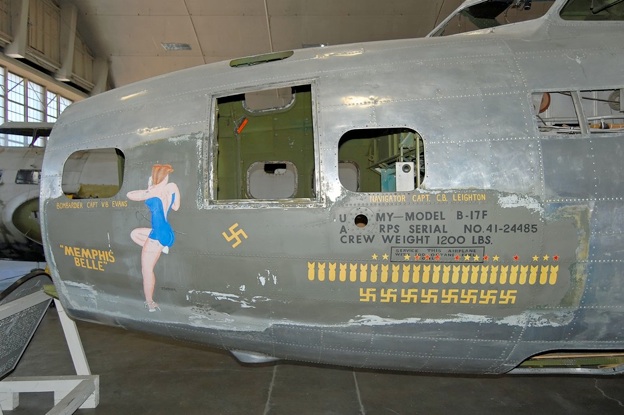
The museum staff is intent on making the restored aircraft as authentic as possible, even components that won't be visible when the airplane is put on permanent display. The attention to detail is quite extraordinary. For example, the original wiring bundles are being preserved or restored with authentic materials. Some of the exposed wiring was torn out by vandals during the many years the Belle was in Memphis or had deteriorated beyond repair. However, a tour guide explained that the museum has obtained a large stock of vintage cable that will be used to recreate those wires, “even though we will never actually run any current through them.”
The fuselage is in sections and the wings have been removed to allow different teams to work on the components independently. All the paint is being stripped from the metal parts since most of it is inauthentic, having been applied after the war during previous restoration attempts in a manner that didn't meet to the museum's rigorous standards. We were told the museum has made one concession to historical fidelity: when the aircraft is repainted, a latex-based pigment will be used to avoid exposing the workers to the oil-based paint used during the War.
Pin-Ups ‘Too Fat’
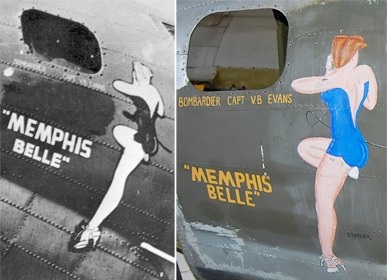
The tail assembly appears to be fully repaired except for the brackets at the tip that were used to mount the twin machine guns. This was the only part of the fuselage that seemed small to me; one can only imagine what it must have been like for the tail gunner, crouching and cooped up under enemy attack in that small space at the very back of the airplane, with insufficient clearance to wear his parachute. Only the gunner who was suspended in the Plexiglas belly turret under the aircraft—which we on the tour didn't see, although we had a good view of the hole in the underside of the fuselage where the ball turret fit—had a worse job.
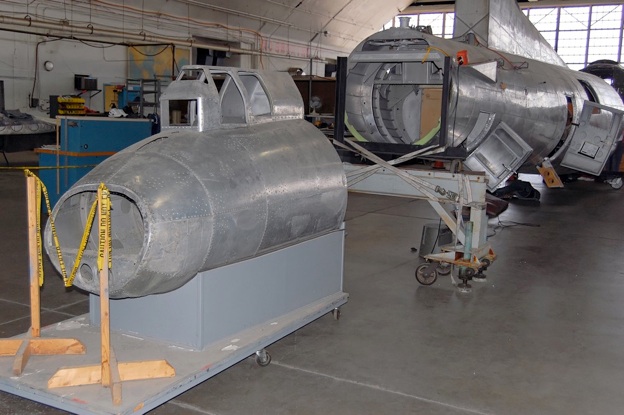
One of the more striking photographs I came away with—an interesting image independent of the subject matter—is a cross-sectional view of the portion of the fuselage where the waist gunners fired their machine guns out of open window ports on each side of the airframe. The interior will be left bare of paint because it wasn't painted during the war. (I presume that was to save weight, but forgot to ask.) In battle, the open windows allowed piercing sub-zero winds to enter the aft section of the aircraft. Gunners whose skin made even momentary contact with exposed metal typically suffered instant frostbite.
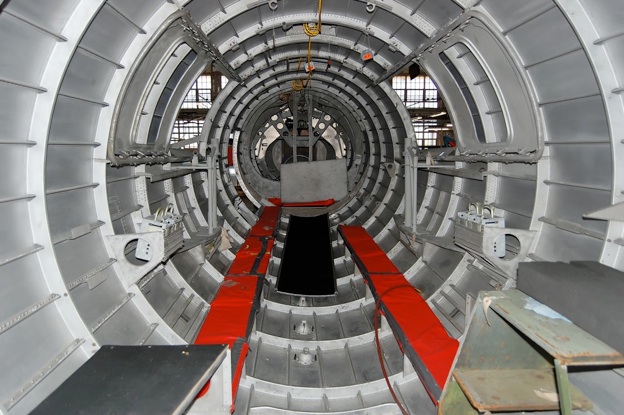
Even in the huge hangar, it was difficult for me to get far enough away to take a wide shot of the front portion of the fuselage, which extends from just aft of the bombardier's nose cone to the wing mounting points. The area immediately surrounding each fuselage component is fairly open to allow easy access for the workers. However, all the machine tool working areas further away were cordoned off from us tourists and I made the picture of the nose and flight deck with my back literally up against one of the work tables. The exterior skin has been cleaned on this side of the aircraft, but the inauthentic paint on the interior hasn't been removed yet.
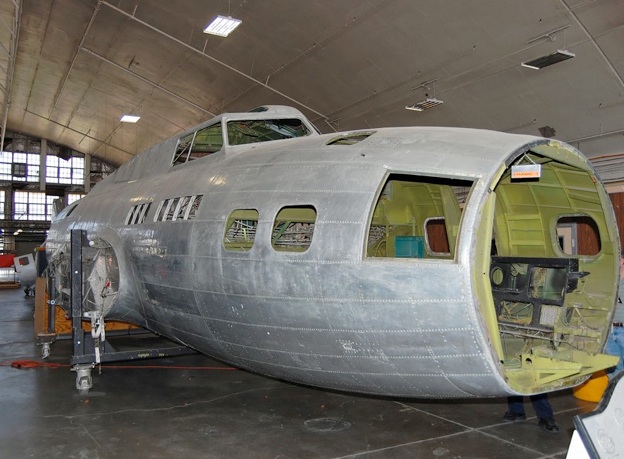
After the process of restoring the Memphis Belle is completed, the aircraft will be moved from the restoration hangar to the Dayton museum, whose exhibit halls already include a faithfully restored B-17 (a later “G” model) and the B-29 “Superfortress” that dropped the atomic bomb on Nagasaki.
Chris Kern
Washington, D.C.
June, 2009
For a follow-up report on the restoration’s progress six years later, see Restoring The Memphis Belle: A 2015 Update.
instagram followers counter burgundy prada sneakers prada t shirts chatgpt ppt discounted prada sunglasses gucci buy 1k instagram followers rosemont restaurants in the park instagram followers analysis authentic prada bag prada compact wallet carlucci's rosemont menu prada clip prada jewelry mens prada bag 2022 kpop instagram followers shoppremiumoutlets.com coupon athenian academy charter school makeup effects rosemont il dining prada wicker clutch prada cleo flap купить гуччи prada impavid sunglasses how to make wigs manage instagram followers prada snakeskin bag prada cloudbust outfit shoppremiumoutlets.com instagram 3000 followers instagram automatic followers aeropostale ofertas prada pet collar prada l'homme edt 50k followers instagram prada perfume sephora wholesale building materials prada ambassador the very first nightingale song gg clothing brand prada green jacket williams fried chicken garland tx italian restaurants in rosemont premium stores prada wallet sale iko nordic electric mashman snow helmet amazing grace cherokee indian prada trifold wallet prada diris prada online prada white pumps prada sweatsuit men's spam followers instagram prada leather handbags prada sneakers cheap prada madrid yacht captain shirt red prada loafers amazon prada bag large framed cork boards popular prada bag like chatgpt carlucci's chicago prada rectangle glasses zadig & voltaire outlet prada illusion sunglasses cheap prada sneakers gucci bags official website prada colors prada pr 14ys chatgpt free online prada saffiano crossbody prada backpack purse colby cooper chatgpt app中文 womens outlets ecc construction price prada shoes instagram followers api neal.mccoy tour chatgpt' m.nii cork board black tamagotchi toys premium shopping outlets yacht club commodore hats prada original bag driftshake shingles mens prada trainers prada mens eyewear orange prada shirt million instagram followers prada 15ws sunglasses chatgpt api pricing prada ballerinas neal.mccoy tour banana republic premium outlets roll of cork board dolce and gabbana outlet online jude and i construction instagram 500 followers puma premium outlet prada bag repairs fabric cork boards genevive jewelry